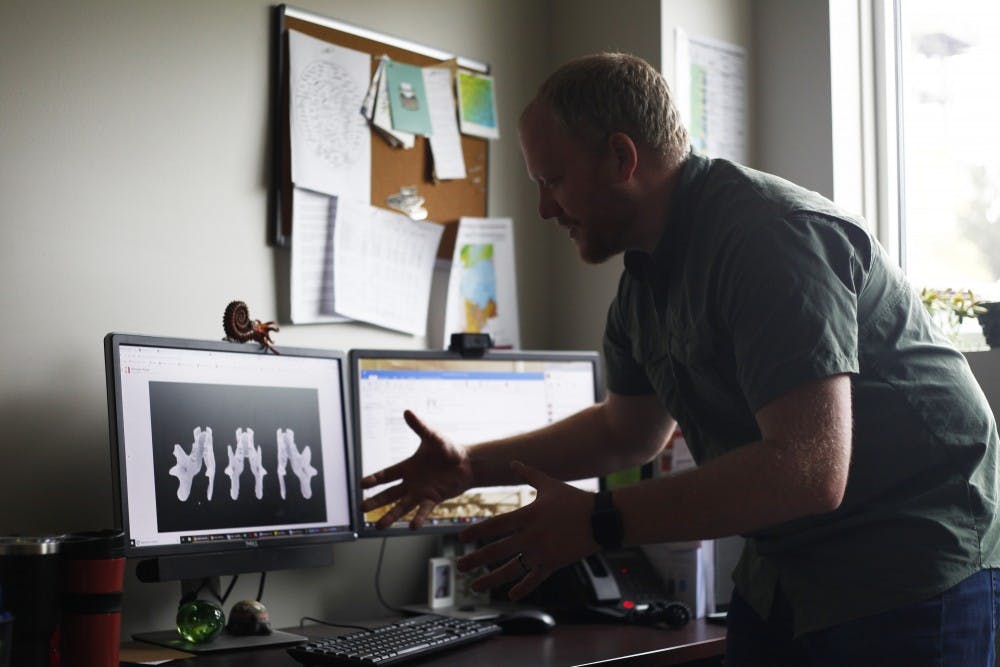At 10 to 12 feet standing up and with sharp claws to dig up plants, the sloth informally called Megajeff is making a comeback at least 10,000 years after extinction.
The IU Megalonyx jeffersonii fossil was one they got rid of in what officials called “the great house cleaning.” Only five bones were salvaged. Now, the IU Indiana Geological and Water Survey is recreating the two-toed sloth’s relative.
IU threw out many of its fossil collections to make room for students after a spike in enrollment in the 1940s, Polly Root Sturgeon, Indiana Geological and Water Survey outreach coordinator said.
“One of the goals of our project is to make sure that we take better care of our collections,” Sturgeon said.
It’s considered to be the most complete fossil of the species even today, Sturgeon said. The paleontologist who named Megajeff did so to honor Thomas Jefferson, who discovered the genus, IGWS assistant director for information services Gary Motz said.
The reconstruction process started earlier this year, according to an IU press release.
Motz said the five original pieces of Megajeff will be 3D-printed to create copies of the bones so the public can more easily interact with them and not break them.
The other missing parts will be filled in by collections from other universities and museums, Motz said. By scanning the fossils and creating digital renderings, they can be printed out and cut using laser cutters. Finally, the entire fossil will be assembled using cardboard cutouts by pairing with the Sidney and Lois Eskenazi School of Art, Architecture + Design.

Motz said the digital renderings will be published with additional information,and people can magnify the bone images. One such detail is a handwritten IU property tag etched into one of the bones.
Motz said IU is pioneering these reconstruction and fabrication techniques, using computerized processes and laser cutters to create the cutout.
“We’re pushing the envelope in a different sector for that blending of arts and sciences, especially in digital fabrication,” he said.
Motz said he wants the Megajeff recreation to look jarring, in order to drive home the fact that IU used to have the fossils. He said he wants the public to question why we don’t still have it.
Sturgeon said David Dale Owen, Indiana’s first geologist, was told about the Megajeff fossil by a group of schoolboys and later added it to his collection in the 1800s. When Owen died, it was sold to IU in the late 19th century.
Despite its importance to paleontology, the fossils were discarded sometime during the 1940s, Sturgeon said. One alumni letter said the bones were thrown out a second-story window of Owen Hall, she said.
“The less you take care of your collections, the less importance they have,” Sturgeon said. “Part of our project is to make sure that never happens again.”
Sturgeon said five bones were salvaged from that cleanup and later placed in the Mathers Museum of World Cultures. However, as the museum expanded and focused more on culture, it gave away the bones to the Indiana State Museum, where they reside today.
Motz said the species not only represents a history of the state but also the country.
Motz said there was a record which talked about how the Megajeff almost didn’t come back to IU. A Philadelphia scientist asked to see the fossil and upon examining it told Owens the specimen wouldn’t be given back. Owens wrote back in a strongly worded letter that he would be in Philadelphia in two weeks to collect it. And he would bring it back.
IU professor and paleontologist David Polly said the preservation of fossils is extremely important because they are the only direct evidence of past life. He said chemists can recreate experiments to test theories, but paleontologists only have one source to determine information: the fossil itself.
“The story of the history of life really does belong to all of us,” Polly said. “Specimens like this particular one, like I said, are part of the history of the state.”
Polly said IU and Indiana in general have been extremely important in the exploration and furthering the studies of geology and paleontology. Other important fossils have been found in the state as well. The first fossil of a Dire wolf, a creature made popular by TV shows such as "Game of Thrones," was found in Evansville, Indiana, in 1854, Polly said in an IGWS article.




